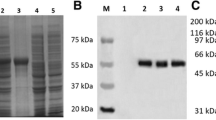Abstract
Based on the understanding that the analysis on unique short (US) region of duck enteritis virus (DEV) might contribute to the recognition of the molecular characterization and the evolution of DEV, in the study, a 5,121 bp fragment, which contained three genes encoding complete US10, unique short region open reading frame (SORF) 3, and US2 proteins, was amplified from the DEV (C-KCE) genome. The transcription orientation of the US10 and SORF3 was in a tail-to-tail way, and the SORF3 and US2 was the same. Potential core promoters and polyadenylation (poly(A)) sites were predicted for US10, SORF3, and US2 and further confirmed by polymerase chain reaction. Phylogenetic analysis for the three complete coding sequences showed that DEV was more closely related to avian herpesviruses, especially to Mardivirus, and should be classified to a separate genus of the Alphaherpesvirinae subfamily.




Similar content being viewed by others
References
E.R. Campagnolo, M. Banerjee, B. Panigrahy, R.L. Jones, Avian Dis. 45, 522–528 (2001). doi:https://doi.org/10.2307/1592999
E.F. Kaleta, A. Kuczka, A. Kühnhold, C. Bunzenthal, B.M. Bönner, K. Hanka, T. Redmann, A. Yilmaz, Dtsch. Tierarztl. Wochenschr. 114, 3–11 (2007)
Y.X. Huang, J.S. China, Agric. Univ. 1, 1–12 (1959)
E.C. Burgess, J. Ossa, T.M. Yuill, Avian Dis. 23, 940–949 (1979). doi:https://doi.org/10.2307/1589610
M.H.V. van Regenmortel, C.M. Fauquet, D.H.L. Bishop, E.B. Carsten, M.K. Estes, S.M. Lemon, J. Maniloff, M.A. Mayo, D.J. McGeoch, C.R. Pringle, R.B. Wickner (eds.), Virus Taxonomy: Seventh Report of the International Committee on Taxonomy of Viruses, (Academic Press, California, 2000), p.221
R. Gardner, J. Wilkerson, J.C. Johnson, Intervirology 36, 99–112 (1993)
R. Longnecker, S. Chatterjee, R.J. Whitley, B. Roizman, Proc. Natl Acad. Sci. USA 84, 4303–4307 (1987). doi:https://doi.org/10.1073/pnas.84.12.4303
B. Roizman, A.E. Sears, Fields Virology, 3rd edn. (Lippincott-Raven Publishers, Philadelphia, PA, 1996), pp. 2231–2295
H. Li, S. Liu, X. Kong, Virus Genes 33, 221–227 (2006). doi:https://doi.org/10.1007/s11262-005-0060-6
C. Sinzger, J. Knapp, K. Schmidt, M. Kahl, G. Jahn, J. Virol. Methods 81, 115–122 (1999). doi:https://doi.org/10.1016/S0166-0934(99)00058-0
Y. Hu, G. Zhang, A. Li, J. Chen, L. Ma, Appl. Microbiol. Biotechnol. 80, 823–830 (2008). doi:https://doi.org/10.1007/s00253-008-1636-6
G.Q. Zhang, S.V. Nguyen, H. To, M. Ogawa, A. Hotta, T. Yamaguchi, H.J. Kim, H. Fukushi, K. Hiraik, J. Clin. Microbiol. 36, 77–80 (1998)
S. Liu, S. Chen, H. Li, X. Kong, Gene 401, 88–96 (2007). doi:https://doi.org/10.1016/j.gene.2007.06.022
M. Kozak, Cell 44, 283–292 (1986). doi:https://doi.org/10.1016/0092-8674(86)90762-2
R.D. Estep, M.F. Powers, B.K. Yen, H. Li, S.W. Wong, J. Virol. 86, 2957–2969 (2007). doi:https://doi.org/10.1128/JVI.01997-06
M.D. Sheets, S.C. Ogg, M.P. Wickens, Nucleic Acids Res. 18, 5799–5805 (1990)
D.J. McGeoch, E.K. Wagner (eds.), Herpesvirus Transcription and its Regulation, (CRC Press, Boca Raton, FL, 1992), pp. 29–47
H.K. Jang, M. Ono, T.J. Kim, Y. Izumiya, A.M. Damiani, T. Matsumura, M. Niikura, C. Kai, T. Mikami, Virus Res. 58, 137–147 (1998). doi:https://doi.org/10.1016/S0168-1702(98)00110-5
K.A. Schat, A. Buckmaster, L.J. Ross, Int. J. Cancer 44, 101–109 (1989). doi:https://doi.org/10.1002/ijc.2910440119
B.M. Gunther, B.G. Klupp, M. Gravendyck, J.E. Lohr, T.C. Mettenleiter, E.F. Kaleta, Avian Pathol. 26, 305–316 (1997). doi:https://doi.org/10.1080/03079459708419213
E.A. Telford, M.S. Watson, K. McBride, A.J. Davison, Virology 189, 304–316 (1992). doi:https://doi.org/10.1016/0042-6822(92)90706-U
Acknowledgments
We thank Prof. Ma LX for kindly providing plasmid pHBM803. This research was supported by Research Fund for the Doctoral Program of Higher Education of China (20070511004).
Author information
Authors and Affiliations
Corresponding author
Rights and permissions
About this article
Cite this article
Hu, Y., Zhou, H., Yu, Z. et al. Characterization of the genes encoding complete US10, SORF3, and US2 proteins from duck enteritis virus. Virus Genes 38, 295–301 (2009). https://doi.org/10.1007/s11262-009-0329-2
Received:
Accepted:
Published:
Issue Date:
DOI: https://doi.org/10.1007/s11262-009-0329-2




